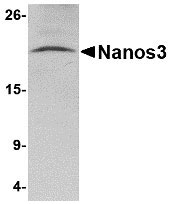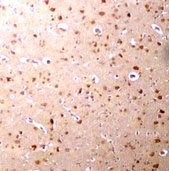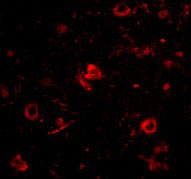Nanos3 Antibody
- SPECIFICATION
- CITATIONS
- PROTOCOLS
- BACKGROUND

Application
| WB, IHC-P, IF, E |
|---|---|
| Primary Accession | P60323 |
| Other Accession | P60323, 41688563 |
| Reactivity | Human, Mouse, Rat |
| Host | Rabbit |
| Clonality | Polyclonal |
| Isotype | IgG |
| Calculated MW | Predicted: 19 kDa Observed: 20 kDa |
| Application Notes | Nanos3 antibody can be used for detection of Nanos3 by Western blot at 2 µg/mL. Antibody can also be used for immunohistochemistry starting at 2.5 µg/mL. For immunofluorescence start at 20 µg/mL. |
| Gene ID | 342977 |
|---|---|
| Target/Specificity | NANOS3; This Nanos3 antibody will not cross-react with either Nanos 1 or Nanos2. |
| Reconstitution & Storage | Nanos3 antibody can be stored at 4℃ for three months and -20℃, stable for up to one year. As with all antibodies care should be taken to avoid repeated freeze thaw cycles. Antibodies should not be exposed to prolonged high temperatures. |
| Precautions | Nanos3 Antibody is for research use only and not for use in diagnostic or therapeutic procedures. |
| Name | NANOS3 |
|---|---|
| Synonyms | NOS3 |
| Function | Plays a role in the maintenance of the undifferentiated state of germ cells regulating the spermatogonia cell cycle and inducing a prolonged transit in G1 phase. Affects cell proliferation probably by repressing translation of specific mRNAs. Maintains the germ cell lineage by suppressing both Bax-dependent and -independent apoptotic pathways. Essential in the early stage embryo to protect the migrating primordial germ cells (PGCs) from apoptosis. |
| Cellular Location | Nucleus. Cytoplasm. Cytoplasm, Stress granule {ECO:0000250|UniProtKB:P60324}. Cytoplasm, P-body {ECO:0000250|UniProtKB:P60324}. Note=Co-localizes with PUM2, EIF2S1 and TIAL1 in the stress granules. Co-localizes with DCP1A in the P-body {ECO:0000250|UniProtKB:P60324} |
| Tissue Location | Ovary, testis and brain (at protein level). In the ovaries, expressed during multiple stages of oogenesis, including primordial, primary, secondary and antral follicles with the highest expression in the oocytes. In the testis, expressed in germ cells, type A spermatogonia (SA), primary spermatocytes (S1), round spermatids (S3) and elongated spermatids. |

Thousands of laboratories across the world have published research that depended on the performance of antibodies from Abcepta to advance their research. Check out links to articles that cite our products in major peer-reviewed journals, organized by research category.
info@abcepta.com, and receive a free "I Love Antibodies" mug.
Provided below are standard protocols that you may find useful for product applications.
Background
Nanos3 Antibody: Nanos is a zinc-finger containing, RNA-binding protein that has been implicated in germ cell development in both invertebrates and vertebrates. In Drosophila, Nanos represses apoptosis during development to ensure proper germ-line development. Unlike Nanos1 whose expression in mice is dispensable, the Nanos2 and Nanos3 proteins are required for germ cell development. Nanos2-null primordial germ cells (PGCs) die only in the male gonads and show no defects in females, while Nanos3-null PGCs are lost during the migration stage regardless of sex. Nanos2 and Nanos3 have distinct expression patterns during embryo development, suggesting that these two proteins do not have redundant functions. However, expression of Nanos2 can at least partially replace Nanos3 function in a Nanos3-null background. Nanos3 expression can not rescue Nanos2-null defects.
References
Lehmann R and Nusslein-Volhard C. The maternal gene nanos has a central role in posterior pattern formation of the drosophila embryo. Development 1991; 112:679-91.
Tsuda M, Sasaoka Y, Kiso M, et al. Conserved role of nanos proteins in germ cell development. Science 2003; 301:1239-41.
Sato K, Hayashi Y, Ninomiya Y, et al. Maternal Nanos represses hid/skl-dependent apoptosis to maintain the germ line in Drosophila embryos. Proc. Natl. Acad. Sci. USA 2007; 104:7455-60.
Haraguchi S, Tsuda M, Kitajima S, et al. Nanos1: a mouse nanos gene expressed in the central nervous system is dispensable for normal development. Mech. Dev. 2003; 120:721-31.
If you have used an Abcepta product and would like to share how it has performed, please click on the "Submit Review" button and provide the requested information. Our staff will examine and post your review and contact you if needed.
If you have any additional inquiries please email technical services at tech@abcepta.com.













 Foundational characteristics of cancer include proliferation, angiogenesis, migration, evasion of apoptosis, and cellular immortality. Find key markers for these cellular processes and antibodies to detect them.
Foundational characteristics of cancer include proliferation, angiogenesis, migration, evasion of apoptosis, and cellular immortality. Find key markers for these cellular processes and antibodies to detect them. The SUMOplot™ Analysis Program predicts and scores sumoylation sites in your protein. SUMOylation is a post-translational modification involved in various cellular processes, such as nuclear-cytosolic transport, transcriptional regulation, apoptosis, protein stability, response to stress, and progression through the cell cycle.
The SUMOplot™ Analysis Program predicts and scores sumoylation sites in your protein. SUMOylation is a post-translational modification involved in various cellular processes, such as nuclear-cytosolic transport, transcriptional regulation, apoptosis, protein stability, response to stress, and progression through the cell cycle. The Autophagy Receptor Motif Plotter predicts and scores autophagy receptor binding sites in your protein. Identifying proteins connected to this pathway is critical to understanding the role of autophagy in physiological as well as pathological processes such as development, differentiation, neurodegenerative diseases, stress, infection, and cancer.
The Autophagy Receptor Motif Plotter predicts and scores autophagy receptor binding sites in your protein. Identifying proteins connected to this pathway is critical to understanding the role of autophagy in physiological as well as pathological processes such as development, differentiation, neurodegenerative diseases, stress, infection, and cancer.




